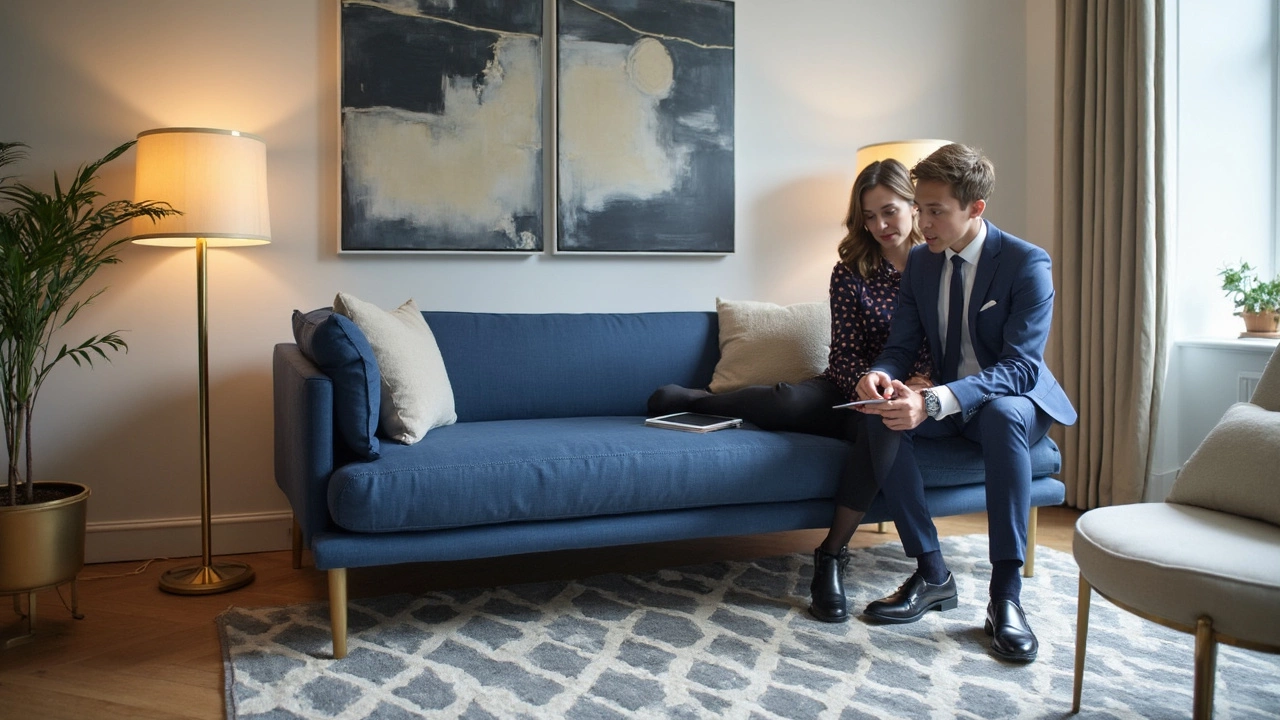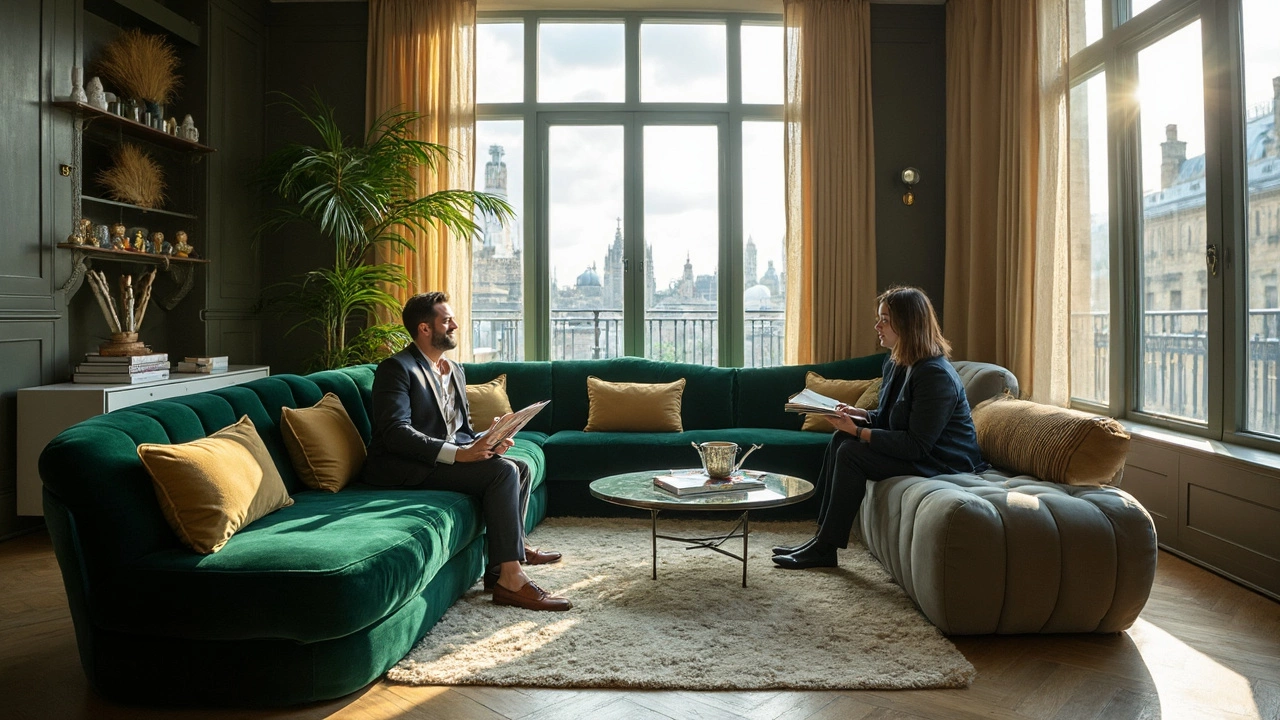If you’ve ever browsed furniture catalogs, you know how places make everything sound fancier. A sofa bed isn’t always just called a sofa bed. You’ll hear terms like “sleeper sofa,” “daybed,” “convertible couch,” or even “pull-out.” You might even spot the word “settee sleeper” thrown in. Most people say “sleeper sofa” when they want to sound a little more high-end, especially in real estate or hotels. There’s no secret handshake—just a handful of fancier words to describe a piece most of us grew up with at our grandma’s house.
But does calling it a “sleeper sofa” change anything beyond the price tag? That’s where things get interesting. Some brands slap on the term “futon” if it’s closer to the Japanese style, especially if the mattress folds, not pulls. Others use “convertible sofa” to signal that this isn’t your basic old pull-out—it’s furniture that can switch roles without looking clunky. In the end, the word you use can actually shape how stylish (or old-school) your living room feels, even if the mechanism is still the same under the hood.
- The Fancy Names People Use
- Why Does the Name Matter?
- Types of Sofa Beds You’ll See in Stores
- Choosing the Right Sofa Bed for You
The Fancy Names People Use
Let’s get real—furniture shops and designers love to dress up the sofa bed with a fancier title. The goal? Make it sound like something you want in your living room even if it still turns into a bed when guests crash. Here are the most common upscale names you’ll see tossed around:
- Sleeper Sofa: Probably the most popular term for a pull-out couch, especially in showrooms and online listings. It’s often used to suggest a step up in quality.
- Convertible Sofa: This makes it sound smooth and modern—think of a couch that flips or folds into a bed without much fuss. It’s not always a pull-out; sometimes the back just pushes down.
- Daybed: Usually has armrests and looks like a bed that turns into a couch or vice versa. It’s more common in smaller spaces or guest rooms. A “trundle” daybed even fits an extra mattress underneath.
- Futon: This is mostly a mattress that folds from couch to bed in one motion. It’s a Japanese original, but you’ll see it all over dorm rooms and studio apartments in the US now.
- Sleeper Loveseat: We’re talking about a small-sized sleeper sofa—fits one, maybe two people (if you’re close).
Some listings even get creative—“pull-out settee,” “convertible lounge,” or the ultra-fancy “guest accommodation unit.” Most people are just trying to make something practical sound a little more inviting.
Curious about which terms people actually search online? Here’s a quick table with 2024 Google search volume data for these names in the US:
| Name | Monthly Searches |
|---|---|
| Sleeper sofa | 14,000 |
| Convertible sofa | 4,400 |
| Daybed | 6,200 |
| Futon | 18,000 |
| Sofa bed | 13,000 |
“Futon” still gets the most Google love, but “sleeper sofa” and “sofa bed” are neck and neck. These numbers change year to year, but you get the idea—don’t stress too much about picking the ‘right’ word. If it works in your space and fits your style, use whatever feels right.
Why Does the Name Matter?
You might wonder if it really makes a difference whether you call it a sofa bed, sleeper sofa, or futon. It actually does, and not just to sound fancy in front of friends. The name you use sets a certain expectation. For example, hotels list "sleeper sofas" in rooms to market comfort and flexibility to travelers. Real estate agents drop “convertible couch” in listings to signal a modern vibe without saying the place is too small for a real bedroom. It’s all about how the space is perceived.
In stores, the label makes a difference, too. "Futon" usually means a lightweight option, often foldable and easy to move—perfect for student apartments. "Sleeper sofa" or sofa bed usually points to something heavier, better built, and with a mattress you pull out. So if you’re shopping and see the term “luxury sleeper,” you’ll know you’re looking at a higher-end product than a casual futon, even if both are technically for sleeping and sitting.
Even design magazines and home blogs use specific terms on purpose. They know people search for “sleeper sofa” more than “pull-out couch” because it just sounds better. So, if you care about the look and feel of your home, picking the right name helps set the style you want—whether that’s practical, modern, or just plain comfortable.

Types of Sofa Beds You’ll See in Stores
Shopping for a sofa bed can get confusing fast, especially when stores start tossing around different names. Here’s a straightforward look at the most common types you’ll actually find on the sales floor or online, so you can pick the best one for your needs and space.
- Sleeper sofa: The classic pick. This one looks like a regular couch, but inside there’s a folded-up mattress (usually on a metal frame) you can pull out for sleeping. You’ll see these in queen, full, or twin sizes. They’re still the go-to for guest rooms and small spaces where you want something that works as both a bed and a couch.
- Futon: Totally different mechanism. The back folds down flat so the whole thing becomes a bed. Futons are usually lighter and lower to the ground. If you’ve ever lived in a college dorm or a first apartment, you know the deal. They’re easy to move and cheaper than most sleeper sofas.
- Daybed: Looks more like a bench or a twin bed with a back and arms. No folding or pulling—just plop a mattress or thick cushion on top. Daybeds are a solid choice if you want something for lounging by day and sleeping at night, without any mechanical parts.
- Pull-out couch/sectional: Some bigger sectionals come with a pull-out bed tucked under one part. This gives you extra sleeping space, sometimes even in king size, without losing your big family sofa vibe in the living room.
- Trundle sleeper: Less popular, but still out there. Looks like a normal sofa or daybed, but there’s a mattress in a drawer underneath that you can pull out and pop up to bed height.
Want the hard facts? Here’s a quick comparison so you know what to expect when you’re in the store:
| Type | Typical Size | Average Price (USD) | Main Mechanism |
|---|---|---|---|
| Sleeper Sofa | Queen, Full, Twin | $600 - $2,500 | Fold-out mattress |
| Futon | Full, Twin | $150 - $600 | Backrest folds flat |
| Daybed | Twin | $200 - $1,000 | No folding—just mattress/cushion |
| Sectional Pull-out | Queen, King | $1,200 - $3,000+ | Pull-out mattress from base |
| Trundle Sleeper | Twin, Full | $250 - $1,100 | Mattress slides/pops out |
When you’re choosing a type, don’t just ask about comfort—think about size, weight, and whether you want something you can drag across the room or move upstairs. If you’ve got pets or kids (like I do), also check out cleaning and fabric options. Sofa beds are way more varied than most people think; there’s truly one for every lifestyle.
Choosing the Right Sofa Bed for You
Picking the perfect sofa bed isn’t just about finding something that looks good. You want it to fit your space, be comfortable for sitting and sleeping, and not make you regret the purchase after a few months. The decision comes down to three main things: function, space, and comfort.
- Function: Figure out how you’ll use it most. If it’s for guests crashing once or twice a year, you can get away with a basic fold-out. If it’s your main couch and guest bed, invest in a sturdy sleeper sofa with a supportive mattress.
- Space: Measure, measure, then measure again. A queen-sized sleeper sofa can easily take over a small room when open. Futons or daybeds usually have a smaller footprint and work well in tighter spaces.
- Comfort: Not all mattresses are created equal. In 2024, most mid-range sofa beds use memory foam or innerspring mattresses. Sit and lie down on the model in-store, or check reviews online if you’re buying sight-unseen.
Consider these quick stats before you buy:
| Type | Average Closed Width | Average Open Length | Best For |
|---|---|---|---|
| Sleeper Sofa | 80 inches | 90 inches | Living rooms, guest rooms |
| Futon | 75 inches | 85 inches | Dorms, studios |
| Daybed | 40 inches | 80 inches | Offices, kid’s rooms |
When my wife Lily and I shopped for ours, we narrowed it down by asking two things: Does it fit our small guest room without blocking the closet, and will someone actually sleep well on it? We picked one with a memory foam mattress and an easy-opening mechanism. It’s not fancy, but it does the job—and no one wakes up stiff or sore.
One more tip: Check return policies and delivery details. Some big box stores have short return windows, and getting a bulky sofa bed in and out of a tight doorway can be tougher than you think. Ask if the legs or arms come off and if the delivery team will handle assembly. You’ll thank yourself later.


Write a comment